The SSD Diaries: Crucial's RealSSD C300
by Anand Lal Shimpi on July 13, 2010 12:39 AM ESTOverall System Performance using PCMark Vantage
Next up is PCMark Vantage, another system-wide performance suite. For those of you who aren’t familiar with PCMark Vantage, it ends up being the most real-world-like hard drive test I can come up with. It runs things like application launches, file searches, web browsing, contacts searching, video playback, photo editing and other completely mundane but real-world tasks. I’ve described the benchmark in great detail before but if you’d like to read up on what it does in particular, take a look at Futuremark’s whitepaper on the benchmark; it’s not perfect, but it’s good enough to be a member of a comprehensive storage benchmark suite. Any performance impacts here would most likely be reflected in the real world.
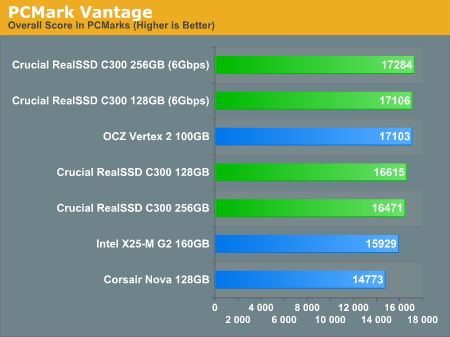
The overall PCMark vantage score puts the OCZ Vertex 2 ahead of the C300 by only 3%. Move to a 6Gbps controller and the C300 is now on par with the Vertex 2. Either way you look at it, general desktop performance should be about the same between the two for workloads exemplified by PCMark Vantage. The real world advantage over the Corsair Nova is 12.5%, just enough to be noticeable. This also reflects what I’ve seen in my own experiences with these drives as a user. There’s a noticeable performance increase between the X25-M/Indilinx class of SSDs and the new guard. It’s not earth shattering, and no where near the gap you see between SSDs and HDDs, but it’s noticeable on fast systems.
The memories suite includes a test involving importing pictures into Windows Photo Gallery and editing them, a fairly benign task that easily falls into the category of being very influenced by disk performance.
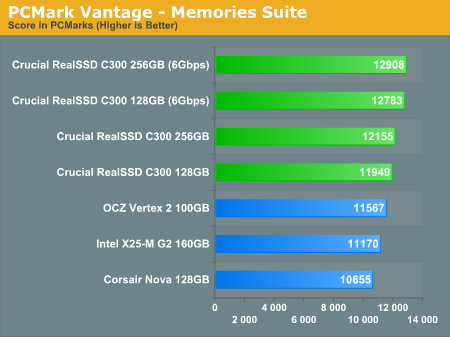
The TV and Movies tests focus on on video transcoding which is mostly CPU bound, but one of the tests involves Windows Media Center which tends to be disk bound.
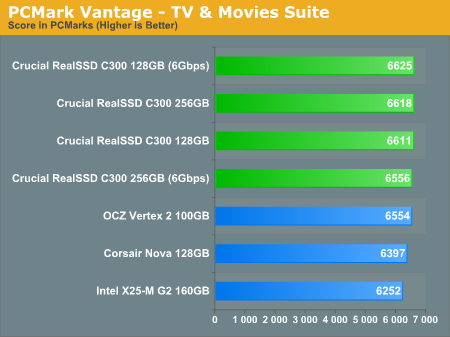
The gaming tests are very well suited to SSDs since they spend a good portion of their time focusing on reading textures and loading level data. All of the SSDs dominate here, but as you'll see later on in my gaming tests the benefits of an SSD really vary depending on the game. Take these results as a best case scenario of what can happen, not the norm.
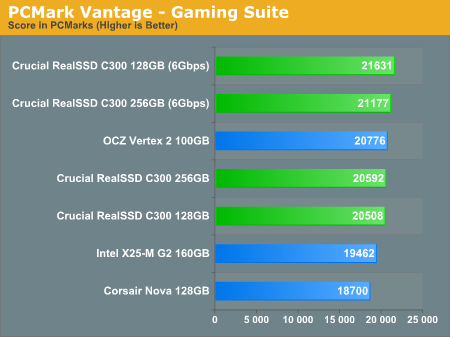
In the Music suite the main test is a multitasking scenario: the test simulates surfing the web in IE7, transcoding an audio file and adding music to Windows Media Player (the most disk intensive portion of the test).
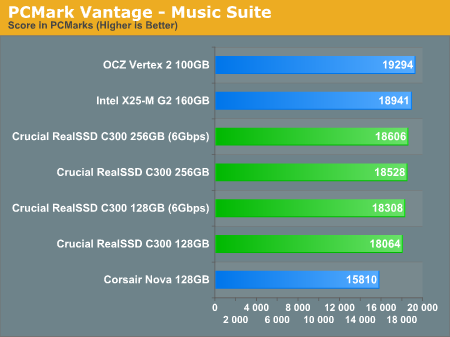
The Communications suite is made up of two tests, both involving light multitasking. The first test simulates data encryption/decryption while running message rules in Windows Mail. The second test simulates web surfing (including opening/closing tabs) in IE7, data decryption and running Windows Defender.

I love PCMark's Productivity test; in this test there are four tasks going on at once, searching through Windows contacts, searching through Windows Mail, browsing multiple webpages in IE7 and loading applications. This is as real world of a scenario as you get and it happens to be representative of one of the most frustrating HDD usage models - trying to do multiple things at once. There's nothing more annoying than trying to launch a simple application while you're doing other things in the background and have the load take forever.

The final PCMark Vantage suite is HDD specific and this is where you'll see the biggest differences between the drives:

In the HDD suite itself, OCZ holds the clear advantage with the Vertex 2 showing up 15% faster than the 128GB RealSSD C300. Moving to a 6Gbps interface basically levels the playing field between the two.










51 Comments
View All Comments
Breit - Wednesday, July 14, 2010 - link
yes, a sandforce drive should be slower in general when used with third party encryption as all data seems random to the drive then and the compression algorithms have nothing to compress. i'm not sure if the sf1200 controller can, but the sf1500 controller definitely can encrypt the data on the drive by themself storing it in an aes-128 encrypted format.quote from the sandforce site:
"DuraClass technology automatically stores data in a secure, AES-128 encrypted format. This also prevents would-be thieves from extracting data directly from the flash memory should they ever have access to the drive."
(http://www.sandforce.com/index.php?id=21&paren...
question is how good or usable their implementation is?! :)
sparkuss - Tuesday, July 13, 2010 - link
I asked this question in a previous review and once again you note your "using the Marvell 88SE9128 controller similar to many motherboards".Did you only use the WIN7 MSAHCI and INTEL IMSM 8.9 on both the onboard SATA2 and Rocket 620?
This is of interest to many on the Crucial boards concerning the lack of TRIM support in Marvell drivers for their 9123/9128 controllers.
mattgmann - Tuesday, July 13, 2010 - link
last year the ssd market was pretty cut and clear with what was good and what wasn't. There have been a lot of advances recently, and it's getting hard to keep track of what manufacturers with what controllers work well in what configurations. I'd really love to see an SSD buying guide with all of the current drives, possibly separated into workstation, laptop, and server use sections.thanks
willscary - Tuesday, July 13, 2010 - link
I just sent my first SSD back to Crucial. I called. They RMA'ed me and will send a replacement ASAP. I am impressed. I have 5 year warranties on the M225 series SSDs, and they never even blinked...send it back and they will replace it.This was the only M225 that I have installed that does not have 1916 firmware.
My comment is on the prices. If any of you recall, I was the guy who already had bought, installed and used 5 Crucial M225 128GB SSDs when I decided to try Sandforce in the OWC SSD. After I bought the SSD and ON THE DAY IT SHIPPED, OWC changed their website and said that the controllers were Sandforce 1200 and not the 1500 that I was told when I puurchased. It was still a good deal, but I was upset with the bait and switch, so I refused delivery and had it returned.
I then purchased a Crucial M225 for myself, this one the 256GB flavor.
I want to say that I have had no problems. Peak reads reach about 240MB/s and average reads are about 215MB/sec with large files. Writes are less, about 175-180MB/sec for larger files. With small files like Anand uses, my writes are about 125MB/sec and my small file reads are about 145MB/sec.
Very small files read and write much slower, in the 5-25MB/sec range, but those are files that are very small...in the 4-20KB range.
What amazes me is the speed. While 5MB/sec may sound slow, it is not, at least when you consider that these are 4KB files. These small files write and read nearly instantly.
I paid $525 for the drive. I have seen them as low as $509. This is a great price! Now that I have seen the newest article here by Anand, I really understand that my outdated M225 is still a great deal at $525.
I would like to see this drive, or a comparable one, listed in the lineup with these newer drives. While not as fast, I believe them to be a good value when sale priced. I even saw a Western Digital 128GB SSD a few weeks ago for $219 with free shipping. They were gone very quickly!
Makaveli - Tuesday, July 13, 2010 - link
That was a good read thanks.pesos - Tuesday, July 13, 2010 - link
Hi Anand,Thanks for the followup review - I have been using a 256gb C300 on each of my Poweredge T710 servers for the last few months with great results.
I am curious - does applying the destructive firmware update restore the drive to peak performance, or should it be coupled with some kind of secure erase?
Thanks,
Wes
elimliau - Wednesday, July 14, 2010 - link
Hi,Has anyone made the above work, mine cant?
Regards,
elimliau
sparkuss - Wednesday, July 14, 2010 - link
elimliau,You need to head over to the Crucial SSD forum. I have seen several threads and posts on that specific card/board.
http://forum.crucial.com/t5/Solid-State-Drives-SSD...
sparkuss - Wednesday, July 14, 2010 - link
EDIT: You may have to register to get that link to work, sorryfoo-bar - Friday, July 16, 2010 - link
This is all very interesting, and new SSDs seems to hit the market constantly. But the differences seems to be mostly software related i.e firmware. What are the bottleneck to get full SATA speed? Is it the NAND flash them selves? And if so, what is on the horizon when it comes to this type of memory?